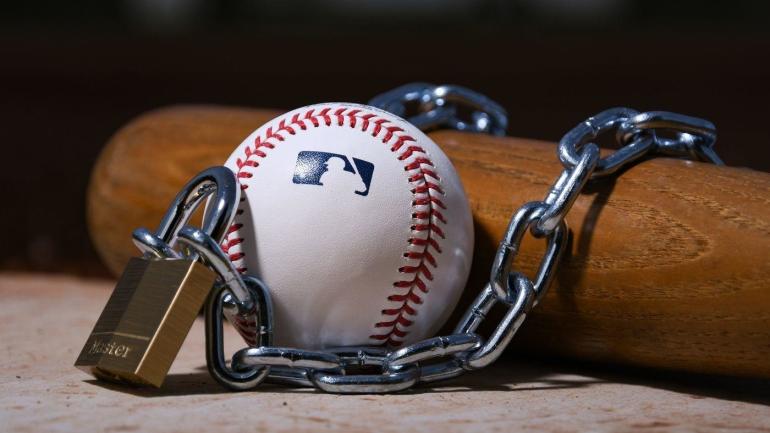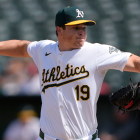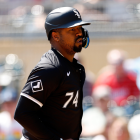
After three months, Major League Baseball's owner-imposed lockout has ended. Major League Baseball and the MLB Players Association reached a deal for a new collective bargaining agreement on Thursday. The union voted to approve a new proposal by a 26-12 margin (a simple majority, or 20 votes, was all that was required for the new agreement to pass, but it's notable that the eight members of the executive subcommittee all voted no).
The lockout came to an end in its 99th day. The owners first enacted the lockout on Dec. 2, when the previous CBA expired, marking MLB's first work stoppage since the 1994-95 players strike. Though the league characterized that act as a defensive mechanism it hoped would hasten negotiations, the owners then waited more than six weeks to make their first proposal. Talks finally heated up in the final week of February, when the two sides daily met in Florida. An agreement was reached Thursday after hours of negotiations this week in New York.
Given the back-and-forth, we here at CBS Sports wanted to provide a crash course on the lockout. Below, you'll find a timeline of the events leading up to the two sides finally reaching an agreement.
Timeline of the lockout
Dec. 2: The lockout began shortly after midnight on December 2, or with the official expiration of the previous CBA. Commissioner Rob Manfred announced in a statement that the 30 owners had voted unanimously in support of the lockout: "We hope that the lockout will jumpstart the negotiations and get us to an agreement that will allow the season to start on time."
Jan. 13: Despite Manfred claiming they intended the lockout to "jumpstart" negotiations, the league waited more than six weeks to make its first proposal, with that coming on Thursday, January 13. The proposal, which was not received well by the union, included an increase in the minimum salary; tweaks to draft-pick compensation; and adjustments to a draft lottery system that would be implemented to curb tanking.
Jan. 24, 25: The two sides met, on consecutive days this time, with the union rejecting most of, if not all of the league's proposal during those sessions. Both sides did concede on various issues during these meetings. The players walked away from asking for age-based free agency and earlier arbitration, and the league scrapped its original request to do away with the "Super Two" tier of the arbitration system.
Feb. 1: The parties met for about 90 minutes to again discuss core economic issues. This meeting was highlighted by the MLBPA lowering its requests as it pertained to curbing service-time manipulation and the size of the bonus pool earmarked to award high-performing players who were in the pre-arbitration phase of their career. The players offered an expanded, 12-team postseason and the universal designated hitter.
Feb. 3: MLB requested the help of a federal mediator to resolve the lockout. The union declined to partake a day later, on Feb. 4, citing how MLB had failed to deliver the counterproposal it had previously promised. "The clearest path to a fair and timely agreement is to get back to the table," an MLBPA statement read.
Feb. 10: Manfred addresses the media for the first time during the lockout. He does not announce an official delay to spring training, as expected, and again expresses his optimism that a deal will be done before the season is compromised.
Feb. 17: The union offers its latest proposal for a CBA framework. In it, the players soften their request for salary arbitration after two years by instead proposing to significantly expand the super-two pool. As well, the players ask to expand the discussed bonus pool for pre-arbitration players.
Feb. 18: MLB officially announced the start of spring training will be delayed one week, from Feb. 26 to March 5. MLB and the MLBPA will meet every day during the week of Feb. 21-25 in an effort to reach a deal that avoids delaying the start of the regular season.
Feb. 21: MLB and the MLBPA met in Florida, though the league did not proposal significant changes. The two sides are expected to meet every day this week.
Feb. 22: MLBPA counters MLB's slightly tweaked proposal with one of its own. The union lessened its ask on how many players with 2-3 years of service time would be arbitration eligible and asked for a slight increase in minimum salary. The two sides did not seriously discuss the luxury tax for the second consecutive day.
Feb. 23: MLB proposes raising the minimum salary by $10,000 a year for the duration of the CBA. A league spokesperson states that Feb. 28 is the deadline before games are cancelled without the intent to make them up. The two sides once again did not seriously discuss the luxury tax.
Feb. 24: MLBPA, on the matter of service time manipulation, proposed granting service time to "fewer players than before, narrowing the scope of it. They also make minor tweaks to their proposed seven-pick lottery and altered their proposal regarding the draft order to reduce penalties on small-market teams posting consecutive losing seasons.
Feb. 25: For the first time, commissioner Rob Manfred attends negotiations in person. The two sides agree to a general framework for a draft lottery. Spring training games are delayed until at least March 8.
Feb. 26: The union offers a comprehensive proposal. Most notably, they drastically lessen their request for expanded "super two" salary arbitration eligibility. Previously, players requested that 75 percent of players with between two and three years of MLB service time be eligible for arbitration. On Saturday, they drop that ask to just 35 percent. Owners, meantime, still want the figure to be 22 percent, where it was during the recently expired CBA. Both sides make small movements in other areas, but Saturday bargaining sessions are characterized as acrimonious.
Feb. 27: The two sides meet for a seventh consecutive day. No proposals are swapped and no items are checked off, yet the league characterizes the day's talks as "productive." The owners reportedly offer the elimination of draft-pick compensation in exchange for increased CBT rates. The league also expressed a willingness to increase the CBT threshold, albeit not by much. The union floated the idea of a "ghost win" structure to an expanded, 12-team postseason. The league was said to not be receptive to the idea.
Feb. 28: This marked the most substantial and lengthy day of negotiations yet. MLB originally said Feb. 28 was the deadline to get a new deal before the league canceled regular-season games and pushed back Opening Day. After 16 hours at Roger Dean Stadium and multiple face-to-face meetings between the sides, MLB pushed back its deadline to March 1. There was progress made in the marathon negotiation session, but the sides left with key economic issues unresolved.
March 1: Another few hours of negotiation did not lead to an agreement prior to MLB's informal 5 p.m. ET deadline. Soon thereafter commissioner Rob Manfred announced the first two regular season series have been canceled. They are the first games baseball has lost to a work stoppage since the 1994-95 strike.
"I had hoped against hope I wouldn't have to have this press conference where I am going to cancel some regular season games," Manfred said following the March 1 deadline. "We worked hard to avoid an outcome that's bad for our fans, bad for our players, and bad for our clubs. Our failure to reach an agreement was not due to a lack of effort by either party."
March 6: MLB and the MLBPA held their first substantive bargaining session since regular season games were canceled. The union submitted a new proposal and expressed a willing to give commissioner Rob Manfred the ability to unilaterally implement rule changes with 45 days notice. That power is tied to the larger economics proposal, however.
March 8: MLB countered the union's latest proposal and raised their 2022 competitive balance tax threshold offer to $228 million, up from $220 million. The MLBPA is seeking $238 million. MLB set a "deadline" for a deal to be reached in which 162 games are played and players received full pay and service time (games that have been canceled would be made up as part of doubleheaders, on off-day, etc.). More games could be canceled if no deal is struck.
March 9: Rob Manfred announced the cancelation of more games. MLB's "deadline" was pushed to Wednesday following 17 hours of bargaining, and while the two sides did close the gap on some economic matters, the biggest sticking point now is an international draft. MLB wants one and the union continues to oppose.
March 10: The lockout ends after 99 days. MLB and the MLBPA reached a deal for a new CBA. Included in the accepted proposal, according to The Athletic's Ken Rosenthal:
- CBT threshold: $230 million in 2023 and peaks at $244 million in final year of CBA
- CBT penalty tier: the introduction of a new tier that starts at $60 million past the threshold (the highest tier used to sit $40 million above the threshold);
- Minimum salary: $700,000 and peaks at $780,000 in final year of CBA;
- Pre-arb bonus pool: $50 million
- Postseason format: 12 teams
- Universal designated hitter
- Amateur draft is 20 rounds
Throughout the process, the union sought to raise the league minimum salary and the Competitive Balance Tax thresholds; implement a centralized bonus pool for pre-arbitration players that would be based on performance; and introduce some measures that would curb anti-competitive behavior, like tanking. The owners, for their part, prioritized an expanded postseason, an international draft, and the power to make rule changes, including, potentially, installing a pitch clock and larger bases, as well as restricting defensive positioning.
What comes next
The owners will ratify the new five-year CBA on Thursday night and MLB's offseason business (trades and free agency) will reopen shortly afterward. Players will report to spring training in the coming days, and MLB teams are set to play a full, 162-game season in 2022. Opening Day is April 7, per CBS Sports HQ's Jim Bowden.






















